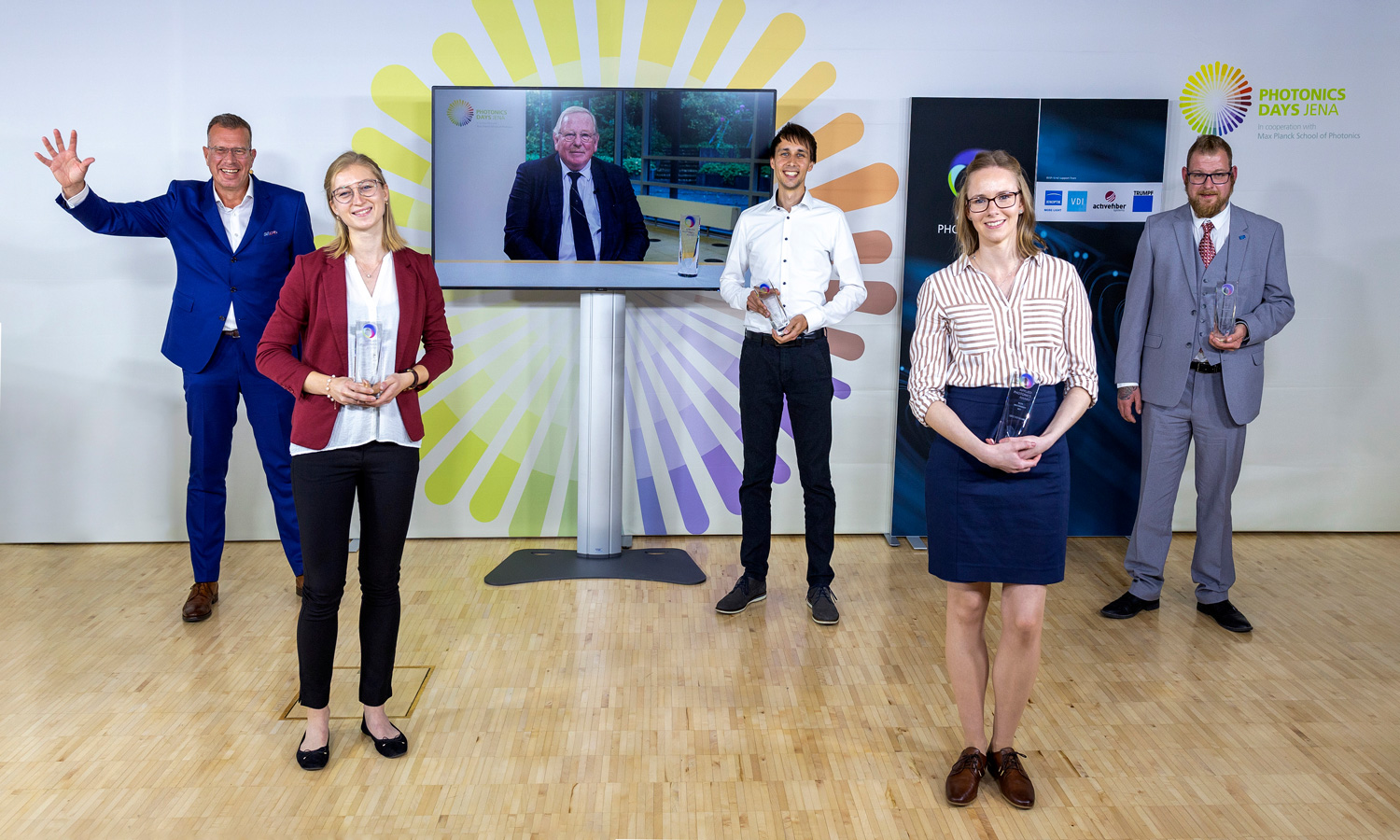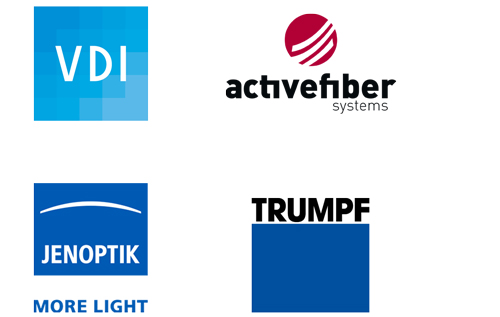Fraunhofer IOF young researcher award for innovative theses presented
"Applied Photonics Award 2021": Award ceremony with Nobel Prize Winner Reinhard Genzel
Clean water, the elimination of space debris, new methods for medical endoscopy, and more powerful lasers - once again innovative theses with a special connection to applied photonics were honored with the "Applied Photonics Award", the young researcher award by the Fraunhofer Institute for Applied Optics and Precision Engineering IOF. The award was presented to the four prize winners on September 29 virtually by Nobel Prize Winner Prof. Dr. Reinhard Genzel as part of the "Photonics Days Jena".
One has already won the Nobel Prize in Physics, the others may still have many great discoveries ahead of them: As part of the "Photonics Days Jena", the international career and networking event of the Fraunhofer IOF and the Max Planck School of Photonics, Prof. Dr. Reinhard Genzel today presented the Fraunhofer IOF's young talent award, the "Applied Photonics Award", virtually to this year's winners.
A jury of experts, consisting of representatives from science and industry, had previously selected the award-winning theses. A total of three theses were awarded in the categories Bachelor, Master/Diploma, and Dissertation. In addition, the jury awarded a jury award for high potential for utilization and application. The winners of the 2021 Award are:
Best Bachelor Thesis (1,000 €)
Katrin Bihr (Furtwangen University): “Depth measurement in endoscopic 3D systems”
Endoscopy is the examination and illumination of hollow organs or the inside of the body with the aid of a medical instrument known as an "endoscope". Stereo endoscopes consist of two cameras and allow a three-dimensional view. However, when using 3D endoscopes, distances and sizes can currently only be roughly estimated by the surgeon via the depth perception of the instrument. This impairs the objective documentation of a finding.
As part of her bachelor's thesis, Katrin Bihr developed a method for determining the depth of an object point in front of the endoscope. The ability to measure tissue and tumors inside the body can represent a major advance for diagnostics and treatment in medicine. This can, for example, enable procedures in cancer therapy to be carried out more gently or in a more targeted manner. But the approach to depth measurement is also applicable beyond the field of endoscopy: stereo camera systems can potentially be used wherever the camera position is fixed relative to the object surface and only a small space is available.
Best Master Thesis (2,000 €)
Luise Hoffmann (Clausthal University of Technology): "Manufacturing and characterization of femtosecond laser-alloyed nickel mesh electrodes for the alkaline water electrolysis"
Femtosecond lasers offer a wide range of applications in medicine and metrology. However, they are also coming into focus in the field of materials processing. Especially in surface processing, the modification of their physical properties enables new fields of application for a wide variety of materials such as semiconductors, glasses, and metals.
In her master's thesis, Luise Hoffmann presents a newly developed three-stage femtosecond laser alloying process. Here, the catalyst material is incorporated into the surface from thin films. The method presented by Hoffmann is applied to produce stable metal alloys of molybdenum as catalyst on nickel net electrodes for the hydrogen evolution side (HER) in alkaline electrolysis of water (AEL), in addition to creating a structured surface.
The process developed by Hoffmann gives rise to a large number of further areas of application, which are also of interest to the industrial sector. Due to current climate policy goals, one of the main focuses of current research is on the generation and storage of hydrogen in order to minimize electrochemical loss phenomena.
Best Dissertation (3,000 €)
Dr. Tobias Schnabel (Bauhaus Universität Weimar): “Photocatalytic degradation of pharmaceutical micropollutants on supported catalysts“
Pollutants in our water that can be removed only slightly or not at all by municipal wastewater treatment plants are referred to as "anthropogenic micropollutants". In his dissertation, Dr. Tobias Schnabel describes how water can be purified with the help of a photonic system. Schnabel's work deals with the use of UV-A LEDs as an excitation source for carrier-bound photocatalysts.
For this purpose, new reaction concepts and catalysts for the oxidation of pharmaceutical micropollutants in the matrix of municipal wastewater were developed and investigated. As part of his work, a photonic system for the cold combustion ("photocatalytic oxidation") of pharmaceuticals in the effluent of municipal wastewater treatment plants was developed, set up and tested under real conditions. The results have shown that it is possible to treat municipal wastewater with a photocatalytic system with relatively low energy requirements.
Jury award for high potential for utilization and application (1,500 €)
Dr. Christoph Stihler (Friedrich Schiller University Jena): “Transverse mode instability - Insights into modal energy transfer in high-power fiber lasers”
Due to their unique properties, fiber lasers enable a wide range of applications already today. High-energy laser radiation is generated by means of a special thin glass fiber and the principle of light conduction. This radiation has an extremely high beam quality compared to that of other laser technologies and can thus be focused on an extremely small area. As a result, applications can be carried out with the highest precision. In addition, the large surface area of the fiber enables efficient cooling. In the past, the average power of fiber lasers could thus be increased almost exponentially without having to sacrifice the excellent beam quality. In 2010, however, this development came to an abrupt halt. Fiber lasers had advanced into a power range in which a new type of thermal effect could be observed. This caused temporal and spatial fluctuations to destroy the otherwise stable and ideal beam profile of the fiber laser. Since then, the phenomenon of so-called "transverse mode instability" (TMI) has hindered further increases in the power of fiber lasers with ideal beam quality.
With his PhD thesis, Dr. Christoph Stihler aims to contribute to a fundamental understanding of mode instability and thus to overcoming the limitations resulting from it. With his findings, he has developed new strategies for suppressing TMI, paving the way for further power scaling of fiber lasers. The higher average power with ideal beam quality has multiple potential applications, including the removal of corrugated space debris by bombarding debris with powerful ground- or satellite-based lasers.

